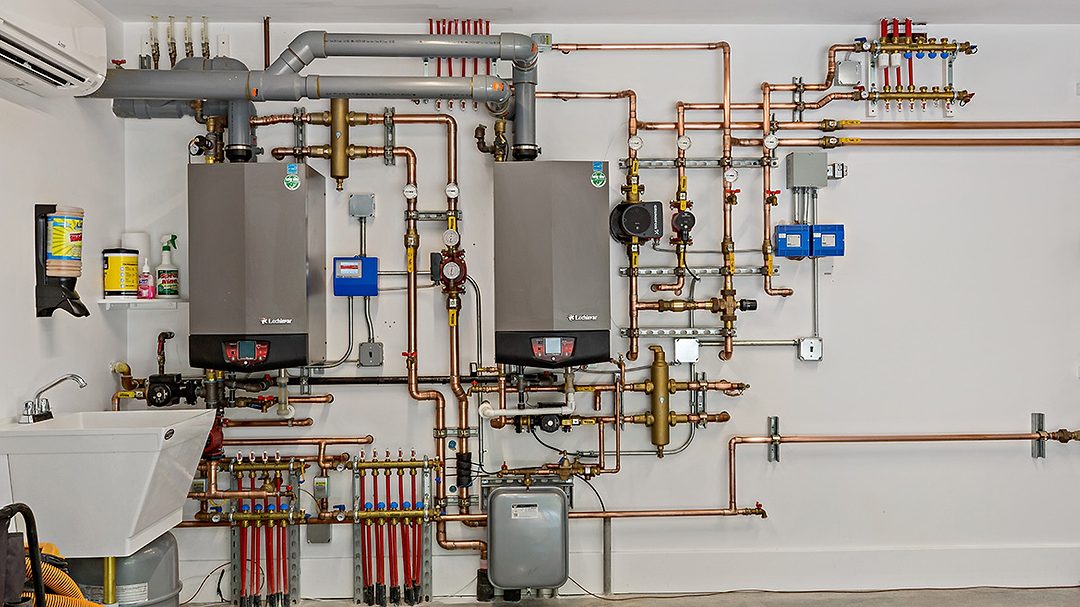Case Study: A Snowmelt System for a Custom New York Home

This new, 3,000 sq-ft (279 sq-m) home owned by Peter and Gina Gasperini overlooks the Hudson River near the Village of Sleepy Hollow, NY. The Gasperinis’ 3-level contemporary features an “upside down” style of living custom-designed by New York architect John Whalen. The home has an open floor plan with living areas, including the kitchen, dining and family room, on the second level and bedrooms on the first level. At ground level is the garage and finished basement.
Photo: Rehau.

Peter Gasperini owns Northeast Radiant, a Pleasantville, NY-based company that specializes in radiant heating and plumbing systems. Since he believes there is no point in building a dream home and skimping on HVAC, Gasperini equipped his home with a Rehau radiant heating and snow and ice melting system designed to operate with exceptional efficiency. For the living areas and bedrooms, the Gasperinis chose a Raupanel radiant system, consisting of 3,000 ft (914 m) of 3/8 in. crosslinked polyethylene (PEXa) pipe laid in aluminum panels installed between the subfloor and flooring material.
Photo: Rehau.

During a typical New York winter, snow and ice are a regular factor and can pose problems if not dealt with right away. The Gasperinis chose a Rehau snow and ice melting (SIM) system for both safety and convenience. As soon as snow or ice begins to develop, the system kicks in automatically to clear outdoor surfaces quickly and efficiently. The system comprises 1,500 ft (457 m) of 3/4 in. Raupex pipe installed under the concrete pebble-finish driveway and in the 16 bluestone steps, landing and entry leading to the home’s front entrance.
Photo: Rehau.

As an experienced contractor, Gasperini had efficiency top of mind in the design of his Rehau radiant heating and snow and ice melting (SIM) system. He decided to supply heat with not one, but two boilers. Plumbing and radiant are primary, while SIM and the heated towel bar are secondary. A benefit of a radiant-only boiler is the maximization of operating efficiency. Without needing to service high-temperature DHW, the radiant boiler operates at a lower temperature and therefore a lower cost. Additionally, the use of a second boiler for the SIM system eliminates more complicated piping arrangements, extra pumps, heat exchangers and labor.
Photo: Rehau.

The master bath features a shower with multiple showerheads, an oversized tub and a towel warmer that is connected to a Rehau Pro-Balance manifold for enhanced control and system efficiency. When combined with two additional showers in the home, the domestic hot water demands can be considerable. Coupling a 200,000 Btu boiler with an 80-gallon indirect storage tank offers plenty of hot water for the various showers.
Photo: Rehau.

An open floor plan provides a seamless transition between the kitchen and living area. While large spaces can be tough to heat evenly, a Rehau radiant heating system with Raupanel can make dreams of an open floor plan feasible without sacrificing thermal comfort.
Photo: Rehau.






Overlooking the Hudson River near the village of Sleepy Hollow, New York, sits a new 3,000 sq-ft dream home owned by Peter and Gina Gasperini. The couple spent years planning and deciding on their “must haves.” Near the top of that list was a radiant heating and snowmelt system from Rehau.
The Gasperinis aren’t the average customer when it comes to radiant heating; they’ve been in the business for years. So, they knew exactly how the Rehau radiant system would provide the level of comfort befitting the home of their dreams.
“Through our business, we’ve worked with many homeowners who understand that there’s more to creating a dream home than just design and aesthetics,” said Peter Gasperini, whose Pleasantville, NY-based company, Northeast Radiant, specializes in radiant heating and plumbing systems.
“It doesn’t make sense to invest significant time, money and effort designing a higher-end home and then skimp on HVAC, or toss in a standard forced-air system as an afterthought,” he said. “The indoor climate system should be on par with the rest of the home; otherwise you’ve made a major compromise.”
The Gasperinis’ three-level contemporary features an “upside down” style of living custom-designed by New York architect John Whalen. The home has an open floor plan with living areas, including the kitchen, dining and family room, on the second level and bedrooms on the first level. At ground level is the garage and finished basement. Walls of windows across the front and west side of the home capture the spectacular views of the Hudson River and Tappan Zee Bridge.
Project: Sleepy Hollow, New York
Type of construction: Single family residence, built 2019
Scope of project: 6,300 ft (1,920 m) of pipe
Architect: John Whalen
Mechanical contractor: Northeast Radiant
REHAU systems used: Raupanel radiant heating and snow and ice melting (Raupex pipe, Pro-Balance manifolds)
For the living areas and bedrooms, the Gasperinis chose a Raupanel radiant system, consisting of 3,000 ft (914 m) of 3/8 in. crosslinked polyethylene (PEXa) pipe laid in aluminum panels installed between the subfloor and flooring material.
“My company was one of first contractors to use Raupanel soon after it hit the market in the early 2000s,” Gasperini said. “We’ve worked with all of the different radiant systems out there, and there’s none better than Rehau. It’s very efficient, you don’t see it…and you feel so comfortable you don’t even think about it.”
To heat the ground-level and garage, 1,800 ft (549 m) of 1/2 in. pipe was fastened to rebar on top of a thermal break insulator. Then the concrete slab was poured, polished and sealed. This method of installing radiant is very cost effective and provides a beautiful, durable finished floor.
During a typical New York winter, snow and ice are a regular factor and can pose problems if not dealt with right away. The Gasperinis chose a Rehau snow and ice melting (SIM) system for both safety and convenience. The system comprises 1,500 ft (457 m) of 3/4 in. Raupex pipe installed under the concrete pebble-finish driveway and in the 16 bluestone steps, landing and entry leading to the home’s front entrance.
Regulating the 38 pipe circuits of the radiant and SIM systems are eight Pro-Balance manifolds, including one for a towel warmer in the master bath and laundry. The heat source is two Lochinvar Knight fire-tube, wall-mounted boilers and a Squire 80-gallon indirect water heater with Grundfos Magna variable-speed circulators, Spirovent air/dirt separators, Honeywell high-flow zone valves (10cv), Tekmar zone managers, Tekmar 670 WiFi snow melting control and Tekmar 090 snow and ice sensor.
As soon as snow or ice begins to develop, the system kicks in automatically to clear outdoor surfaces quickly and efficiently.
“We love not having to shovel or pay a contractor for snow removal, and also not having to worry about the potential hazard of slippery steps,” Gasperini said. “We’re actually able to truly enjoy a snowfall.”
After being in the home for three winters, the Gasperinis agree that Rehau systems help make their dream home all they imagined: Comfortable, peaceful and safe.Experience leads to efficient design
Gasperini used his years of experience as a radiant contractor when designing the mechanical and plumbing systems. “I always try to make my systems as simple to install and service as possible, while also providing exceptional efficiency. This saves on materials and controls operating costs,” he said.
A high-level overview of the sequence of operations is: Start-up > Plumbing > Radiant > SIM > Towel Bar > Shutdown. With heat supplied by two boilers, plumbing and radiant are primary and SIM and the heated towel bar are secondary.
Heat precisely tailored to radiant and towel bars
While the system may seem complicated, Gasperini curated a simple selection of components to supply both the radiant heating system and the heated towel bars:
- A Grundfos variable speed hi-efficiency circulator serves the 6 radiant zones and is capable of running all zones at once or only those in operation, providing the perfect flow in any situation.
- The Lochinvar boiler is equipped with a smart control that knows if the call is for radiant or the heated towel bars and dispatches the water at the appropriate temperature for the call. This feature eliminates the need for an expensive, stand-alone control system.
- An Oventrop three-way thermostatic mixing valve is set at the maximum water temperature for the radiant heating system. The valve prevents higher temperature water meant for the heated towel bar from entering the radiant system, which could exceed the recommended floor surface temperature.
Dedicated SIM boiler serves double duty
A second boiler supplies the SIM system, eliminating more complicated piping arrangements, extra pumps, heat exchangers and labor. Since the SIM boiler would be needed only a dozen or so times per year, Gasperini decided to enlist it for domestic hot water production as well.
The master bath includes an oversized tub and shower with multiple showerheads. When combined with the two additional showers in the home, the domestic hot water demands can be considerable. “Pairing the 200,000 Btu boiler with an 80-gallon indirect storage tank provides tons of hot water when needed,” said Gasperini.
Are two boilers overkill?
Gasperini doesn’t think so. He explained that having a boiler focused only on the radiant heating system maximizes operating efficiency. Especially in a new home as well-insulated as his, the radiant system is set to operate at moderate water temperatures. Without needing to service high-temperature DHW, the radiant boiler operates at a lower temperature and therefore a lower cost.
Looking for a reprint of this article?
From high-res PDFs to custom plaques, order your copy today!













